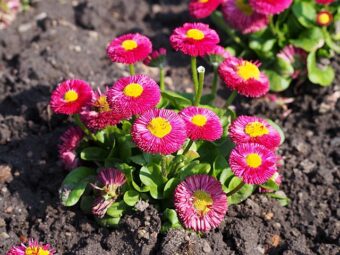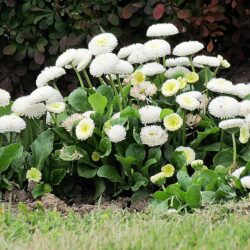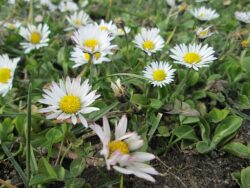In this article, we will discuss how to grow Bellis species in Containers. They are early flowering daises that are used as bedding plants and are a relative to those daisies found in the lawn. The main difference is that Bellies are larger flowering and come in a range of pastel colours. In this article, we will discuss how to successfully grow these biennials in containers.

Bellis perennis has a long history in the garden; it has been a popular flower in medieval gardens and to this day, many see it as an old-fashioned, cottage garden favourite.
They make a cheerful addition to any garden display, where it can be used in front of container displays. They have glossy leaves and attractive single, semi-double and pompon-like blooms that come in shades from white to pink to deep-red. They can also be multi-coloured and so adding to its appeal. They tend to be shirt plants and only grow up to 20cm in height,
GROWING BELLIS PERENNIS IN CONTAINERS
You have two choices to how to grow Bellis perennis in the garden; by either growing from seed or by planting garden-ready plants bought from the garden centre.
GROWING FROM SEED
You can sow seeds six to eight weeks before the final frost date so that they will be garden ready in May.
First, fill a seed tray with seed sowing compost and water well to ensure the growing media is moist. Sprinkle the seeds thinly on top of the compost surface and then cover them lightly with more sieved seed compost. Cover with a propagation lid and place them on a sunny windowsill.
After a few weeks, the seeds will germinate and soon they will be large enough to prick out and be transplanted into individual cells tray or 7.5cm pots, full of multipurpose compost. Once the plant is large enough it can be acclimatized and hardened off before planting in containers outside. They should start flowering in March to May the following year.
GARDEN-READY PLANTS IN CONTAINERS
At this stage, you can plant the garden-ready plants, the same way as your home-reared seeds.
First, find a container that is in proportion to the plant size. Make sure it has plenty of drainage holes and add a 1cm layer of gravel, On top of this, add a good quality multipurpose compost.

Dig a hole slightly bigger than the root ball it came in its original container and make sure that the top of the root ball is at the same level as the top level of the compost. Backfill with the growing media, ensuring any gaps is filled with more compost, Firm the plant in and water well. Plant each Bellis at least 10cm apart from each other.
You will need to keep the compost on the dry side and only water when 5cm below the top of the surface of the compost feels dry to the touch.
You will need to feed every week once in flower with a high potash liquid fertilizer such as Phostrogen at the manufacturer’s recommended dosage. In the first year feed with a normal liquid fertilizer at monthly intervals.
You will need to grow them in full sun for them to be at their best. One thing you must do is to deadhead them regularly to encourage them to bloom more and to make the plant look attractive. If you do this you can get flowers from spring to autumn.
PESTS AND DISEASES
Generally, the plants tend to be pests and diseases free but they can suffer from aphids. This is best dealt with by spraying jets of water as them or if it is really bad, you can use a systemic insecticide and use them recommended by the manufacturer.
One additional problem is in hot weather the plant will suffer and it will flower less. You will need to grin and bear it until the heatwave passes.
VARIETIES TO GROW

There are many varieties of Bellis perennis that you can either buy as seeds or in cell packs from garden centres.
‘Bam Bam Mixed’ has semi-double, large, red-pink flowers.
‘Bright Carpet’ has small, double blooms in red, white and pink.
‘Bellisima Mixed’ has white, pink and red mixed double blooms.
‘Goliath’ has red, pink and white double flowers,
‘Pomponette Mixed’ produces masses of tiny, pompon-like, double blooms that come in red, pink and white.
‘Spring Star’ has fluffy, double red, pink and white flowers.
CONCLUSIONS
In this article, we have discussed how to grow Bellis species in containers, especially Bellis perennis. A plant that has been extensively bred to create the colours we are all familiar with, They are easy to grow, only requiring regularly feeding, watering when the compost is dry, and deadheading to extend the blooming period.
You have so many varieties to choose from and so many bright colours to line your container with.
If you have any questions or comments on growing Bellis species in containers, please do so in the comment box below.
Happy Bellis growing.
